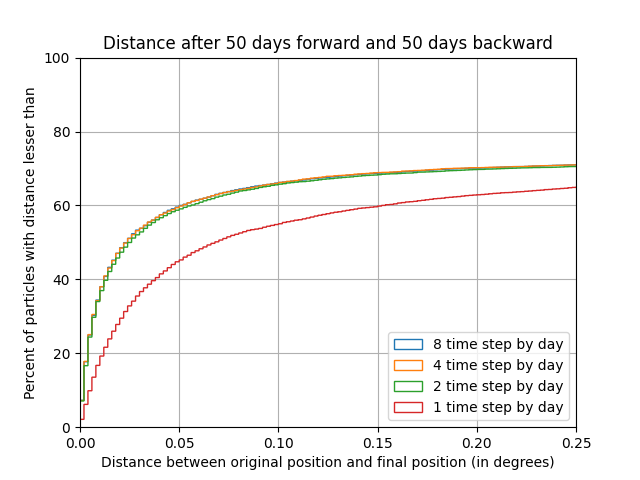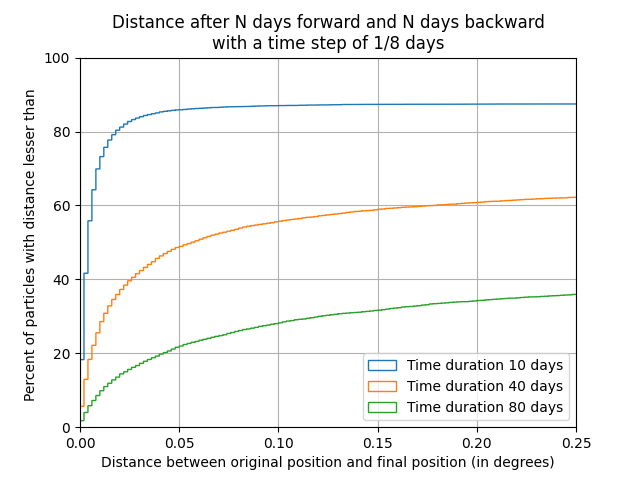Note
Go to the end to download the full example code or to run this example in your browser via Binder
Time advection¶
Example which use CMEMS surface current with a Runge-Kutta 4 algorithm to advect particles.
from datetime import datetime, timedelta
# sphinx_gallery_thumbnail_number = 2
import re
from matplotlib import pyplot as plt
from matplotlib.animation import FuncAnimation
from numpy import arange, isnan, meshgrid, ones
from py_eddy_tracker import start_logger
from py_eddy_tracker.data import get_demo_path
from py_eddy_tracker.dataset.grid import GridCollection
from py_eddy_tracker.gui import GUI_AXES
start_logger().setLevel("ERROR")
class VideoAnimation(FuncAnimation):
def _repr_html_(self, *args, **kwargs):
"""To get video in html and have a player"""
content = self.to_html5_video()
return re.sub(
r'width="[0-9]*"\sheight="[0-9]*"', 'width="100%" height="100%"', content
)
def save(self, *args, **kwargs):
if args[0].endswith("gif"):
# In this case gif is used to create thumbnail which is not used but consume same time than video
# So we create an empty file, to save time
with open(args[0], "w") as _:
pass
return
return super().save(*args, **kwargs)
Data¶
Load Input time grid ADT
c = GridCollection.from_netcdf_cube(
get_demo_path("dt_med_allsat_phy_l4_2005T2.nc"),
"longitude",
"latitude",
"time",
# To create U/V variable
heigth="adt",
)
/home/docs/checkouts/readthedocs.org/user_builds/py-eddy-tracker/conda/latest/lib/python3.10/site-packages/numpy-1.24.3-py3.10-linux-x86_64.egg/numpy/ma/core.py:1020: RuntimeWarning: overflow encountered in multiply
result = self.f(da, db, *args, **kwargs)
Anim¶
Particles setup
Function
def anim_ax(**kw):
fig = plt.figure(figsize=(10, 5), dpi=55)
axes = fig.add_axes([0, 0, 1, 1], projection=GUI_AXES)
axes.set_xlim(19, 30), axes.set_ylim(31, 36.5), axes.grid()
line = axes.plot([], [], "k", **kw)[0]
return fig, axes.text(21, 32.1, ""), line
def update(_):
tt, xt, yt = f.__next__()
mappable.set_data(xt, yt)
d = timedelta(tt / 86400.0) + datetime(1950, 1, 1)
txt.set_text(f"{d:%Y/%m/%d-%H}")
Particules stat¶
Time_step settings¶
Dummy experiment to test advection precision, we run particles 50 days forward and backward with different time step and we measure distance between new positions and original positions.
fig = plt.figure()
ax = fig.add_subplot(111)
kw = dict(
bins=arange(0, 50, 0.002),
cumulative=True,
weights=ones(x0.shape) / x0.shape[0] * 100.0,
histtype="step",
)
kw_p = dict(u_name="u", v_name="v", nb_step=1)
for time_step in (10800, 21600, 43200, 86400):
x, y = x0.copy(), y0.copy()
nb = int(30 * 86400 / time_step)
# Go forward
p = c.advect(x, y, time_step=time_step, t_init=20181.5, **kw_p)
for i in range(nb):
t_, _, _ = p.__next__()
# Go backward
p = c.advect(x, y, time_step=time_step, backward=True, t_init=t_ / 86400.0, **kw_p)
for i in range(nb):
t_, _, _ = p.__next__()
d = ((x - x0) ** 2 + (y - y0) ** 2) ** 0.5
ax.hist(d, **kw, label=f"{86400. / time_step:.0f} time step by day")
ax.set_xlim(0, 0.25), ax.set_ylim(0, 100), ax.legend(loc="lower right"), ax.grid()
ax.set_title("Distance after 50 days forward and 50 days backward")
ax.set_xlabel("Distance between original position and final position (in degrees)")
_ = ax.set_ylabel("Percent of particles with distance lesser than")

Time duration¶
We keep same time_step but change time duration
fig = plt.figure()
ax = fig.add_subplot(111)
time_step = 10800
for duration in (10, 40, 80):
x, y = x0.copy(), y0.copy()
nb = int(duration * 86400 / time_step)
# Go forward
p = c.advect(x, y, time_step=time_step, t_init=20181.5, **kw_p)
for i in range(nb):
t_, _, _ = p.__next__()
# Go backward
p = c.advect(x, y, time_step=time_step, backward=True, t_init=t_ / 86400.0, **kw_p)
for i in range(nb):
t_, _, _ = p.__next__()
d = ((x - x0) ** 2 + (y - y0) ** 2) ** 0.5
ax.hist(d, **kw, label=f"Time duration {duration} days")
ax.set_xlim(0, 0.25), ax.set_ylim(0, 100), ax.legend(loc="lower right"), ax.grid()
ax.set_title(
"Distance after N days forward and N days backward\nwith a time step of 1/8 days"
)
ax.set_xlabel("Distance between original position and final position (in degrees)")
_ = ax.set_ylabel("Percent of particles with distance lesser than ")

Total running time of the script: ( 0 minutes 26.041 seconds)